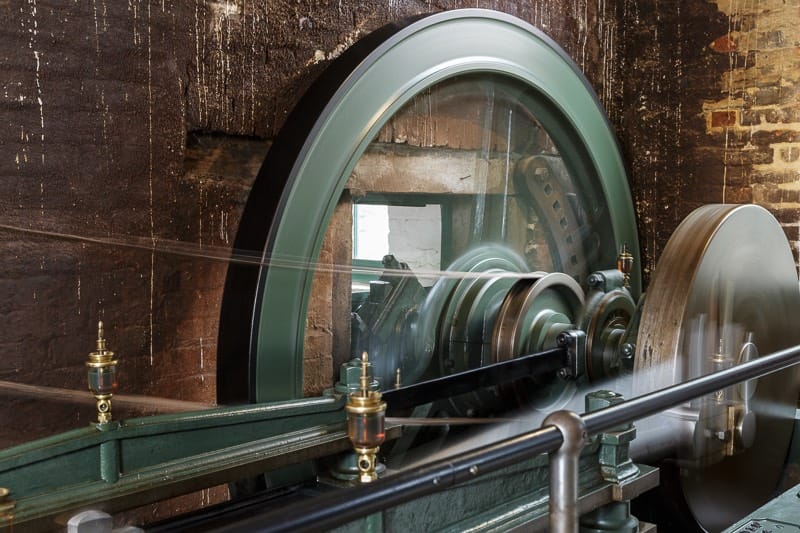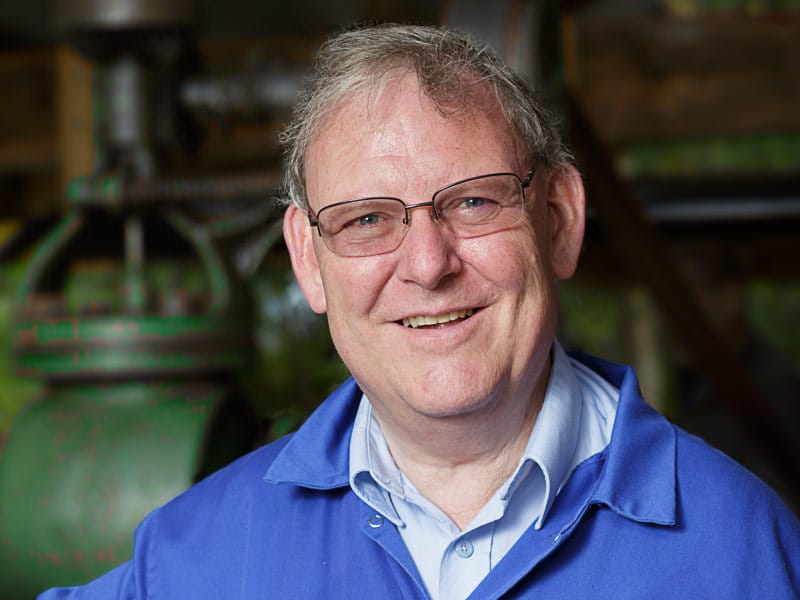We finish up our story of Bursledon Brickworks Museum volunteer Bob Palmer, with a quick…
Astronomy – To infinity and beyond: Part Two
2.
Astronomy – To infinity and beyond: Part Two
In part one we looked at some of the history surrounding The Hampshire Astronomical Group, and how Graham was attracted to Astronomy as a young boy. This time we get to look at some of the equipment and talk about the images obtained from the groups observations.
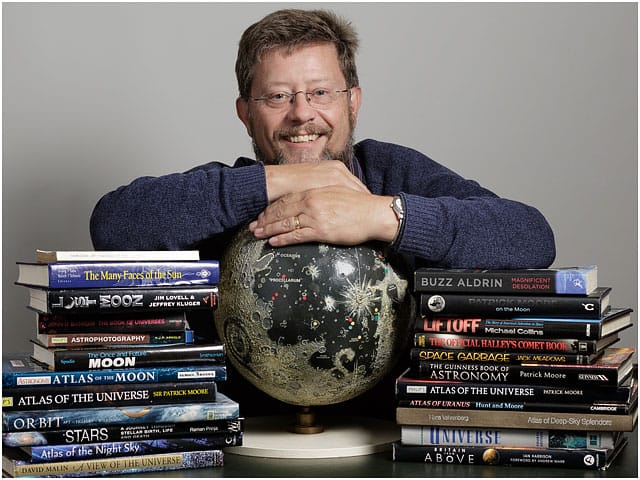
Hardware
You have five telescopes at the current site, what does the quoted sizes of 5, 7, 12, 16 & 24 for the domes actually mean?
It’s the diameter of the optic. The larger the width, the greater the amount of light that enters the lens, the more you can see. A lot of people ask ‘how far can you see?’ That’s the wrong question. Distance is irrelevant if there isn’t enough light to see. The bigger the optic the greater the resolution (physical size) of the image as well.
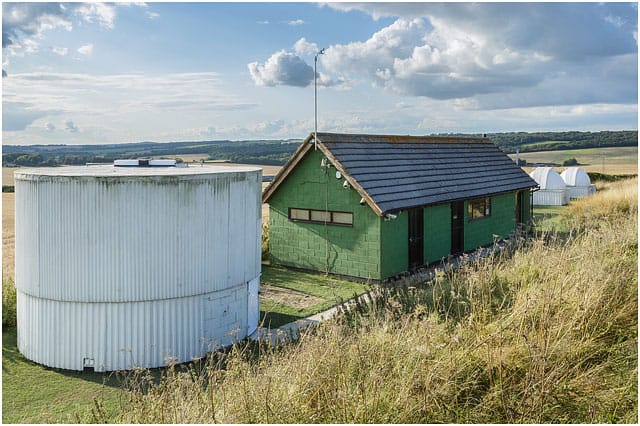
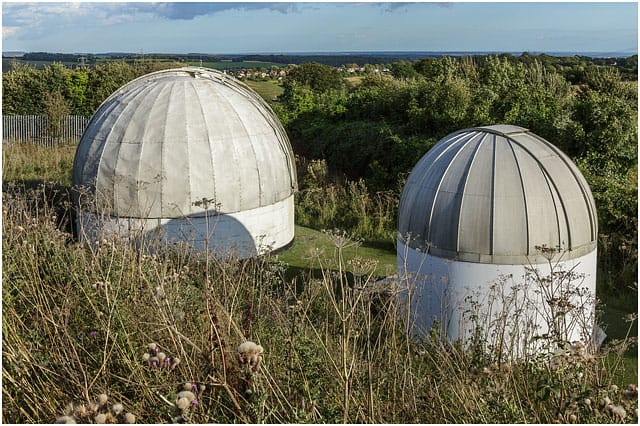
The other three are reflector or mirror telescopes, which are twelve, sixteen and the twenty-four inches across, respectively. These are a later design and are the most common in modern-day astronomy. The light travels down the tube, bounces off the large mirror at the base, back up to a smaller mirror and, very often, out through the side of the tube via an eyepiece. That’s certainly the case with the ones that we have.
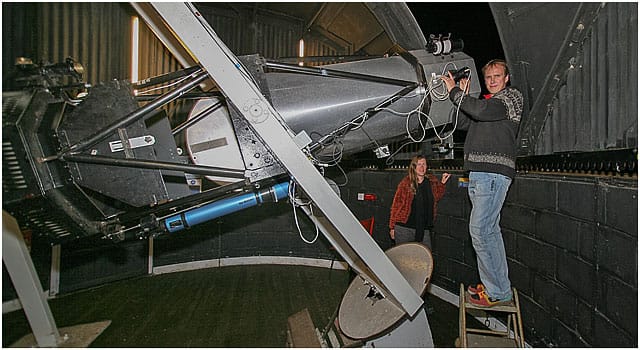
REF: Refracting telescope
A refracting, or refractor, telescope is a type of optical telescope that uses a lens to gather light from the object being observed, and focuses the light rays to produce the image. The design was originally used in spy glasses and astronomical telescopes, but is also used for long focus camera lenses.
http://en.wikipedia.org/wiki/Refracting_telescope
A refracting, or refractor, telescope is a type of optical telescope that uses a lens to gather light from the object being observed, and focuses the light rays to produce the image. The design was originally used in spy glasses and astronomical telescopes, but is also used for long focus camera lenses.
http://en.wikipedia.org/wiki/Refracting_telescope

REF: Reflecting telescope
A reflecting telescope (also called a reflector) is an optical telescope which uses a single, or combination of curved mirrors that reflect light and form an image. Invented in the 17th century, it was an alternative to the refracting telescope which, at that time, was a design that suffered from severe chromatic aberration. It’s a design that allows for very large diameter mirrors or lenses.
http://en.wikipedia.org/wiki/Reflecting_telescope
A reflecting telescope (also called a reflector) is an optical telescope which uses a single, or combination of curved mirrors that reflect light and form an image. Invented in the 17th century, it was an alternative to the refracting telescope which, at that time, was a design that suffered from severe chromatic aberration. It’s a design that allows for very large diameter mirrors or lenses.
http://en.wikipedia.org/wiki/Reflecting_telescope
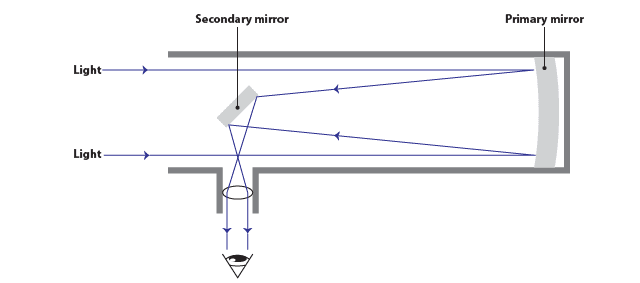
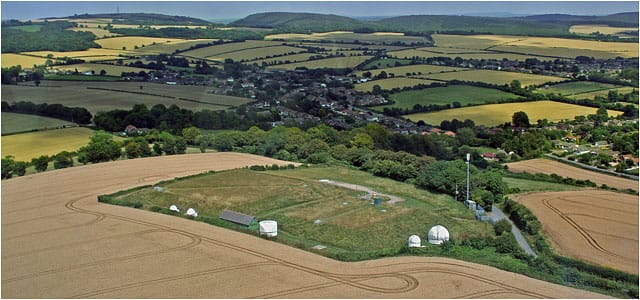
Yes, the twelve-inch reflector, but I let members use it. I’ve had it, in various construction phases, for about twenty years.
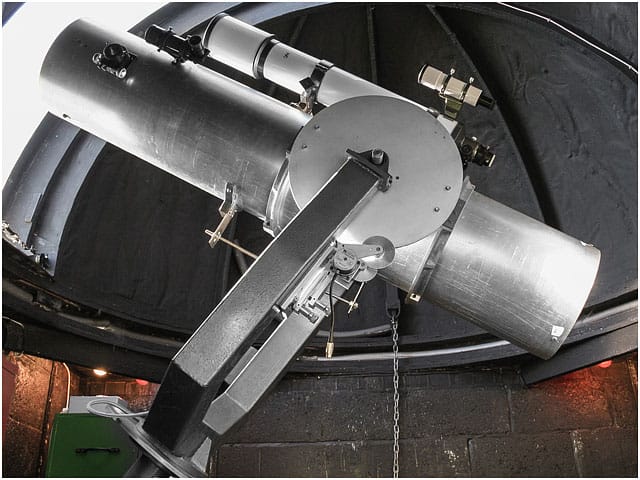
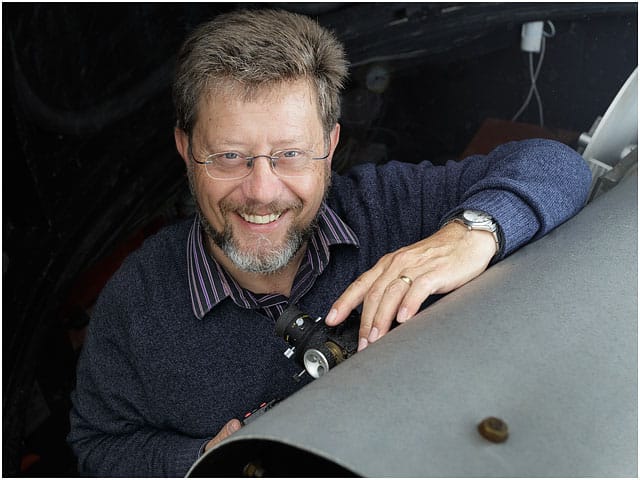
I believe that you’ve just replaced your current 24 inch telescope
Yes, we’ve just had a new one built out in Germany. This one is a Ritchey–Chrétien design, which folds the light path back on itself, thereby allowing the tube to be half the length. This is the same optical configuration as the Hubble telescope, but without the error [laughs]. We’re aiming to have the official opening to the public in October of this year.
![Hampshire astonomical group twenty four inch dome flooring foundations preparation Replacing the foundations ready for the new 24inch Telescope [Photo’s supplied by Graham]](https://www.stevehughesphotography.co.uk/wp-content/uploads/2014/09/HAG-24-inch-dome-flooring-foundations.jpg)
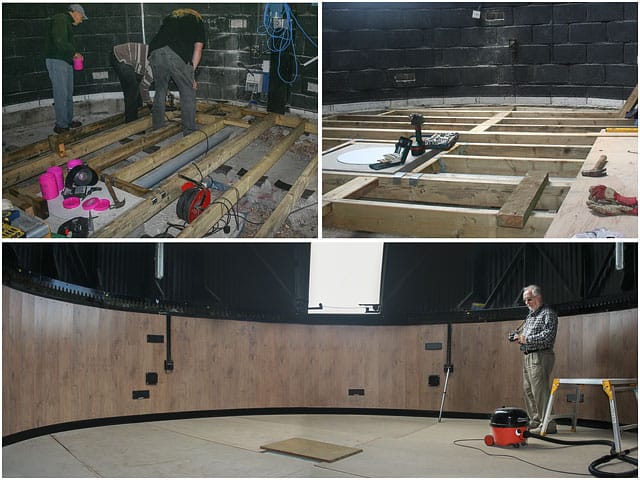
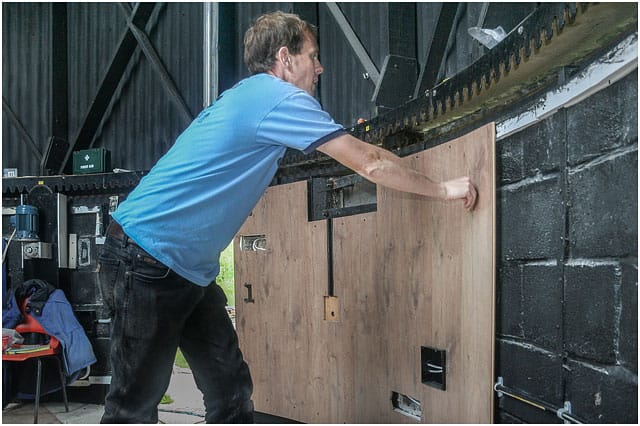
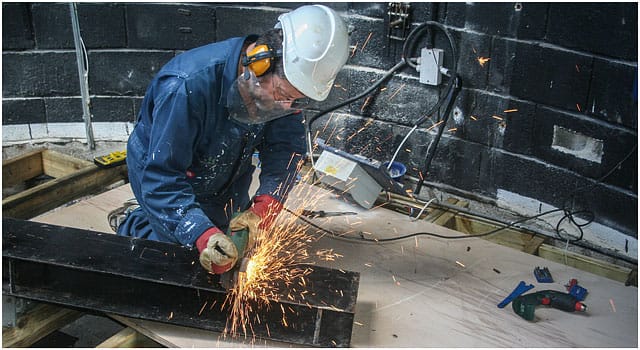
REF: Hubble Telescope
Although the Hubble telescope’s mirror was probably the most precisely figured mirror ever made, it had been ground to the wrong shape.
Although the Hubble telescope’s mirror was probably the most precisely figured mirror ever made, it had been ground to the wrong shape.
What improvements are you expecting from the new 24inch?
It will be an order of magnitude in improvement. We had some quality problems when our earlier 24 inch mirror was ground, which were never really solved. This resulted in a fudge, on our part, to overcome some of its limitations. The new telescope will also be able to track that much better. The old telescope had a ball joint at the bottom, with a motorcycle chain drive. Nothing worth its salt today would have that as a means of controlling the tracking, but at the time, back in the 1960’s/1970s, it served its purpose. Nowadays, the equipment that we attach to the telescopes, camera’s and other recording devices, are a lot more sensitive, so we need a tracking system that will be more in line with them.
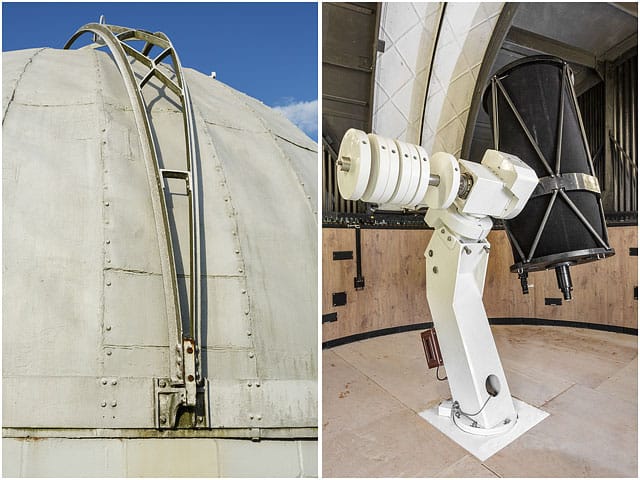
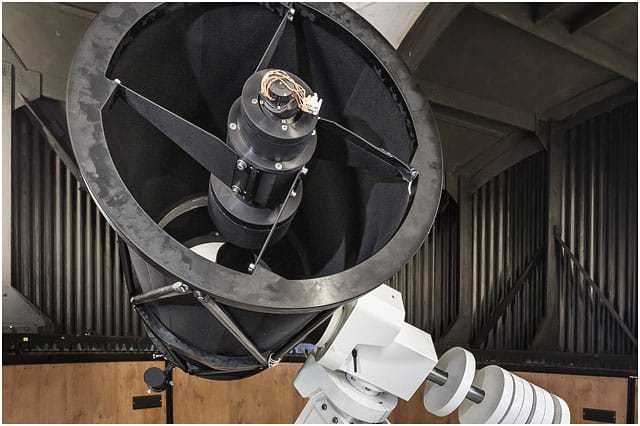
Quality aside, will you be able to do anything that you couldn’t do before?
Because we can track for a longer period, we’ll be able to go deeper in our observations. We’ve gotten around this previously by the process of ‘stacking’ image exposures. For example, by putting ten one minute exposures together, we achieve the equivalent of a single ten minute recording. Now, we will be able to do a ten-minute exposure in one go, which will give us a better quality and, potentially, a more accurate image.
One of the other major benefits is that, with the older telescope, the observing port was right at the top of the tube, some three or four meters off of the ground. This made it difficult for the less able, or anyone in a wheelchair, to be able to use it. With the new design, the eyepiece is at the lower end, so we can observe standing on the ground, which is a massive improvement.
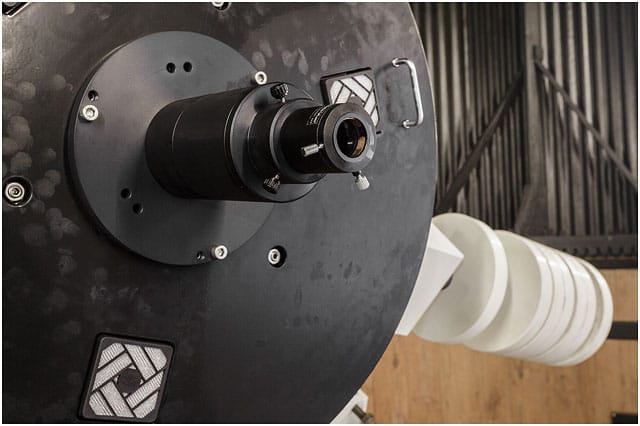
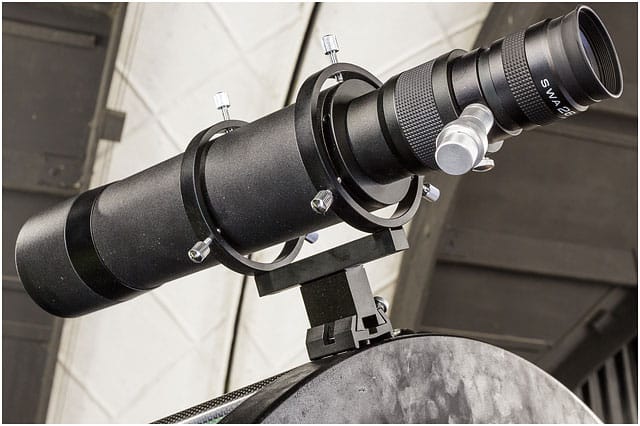
Does everything depend upon computers now?
The tracking drive on four of the five telescopes is computer controlled. It is possible to run them without, but it’s a very crude, manual process, which reduces the accuracy. Also, with experience, you can set the computer to offset the drive to track something unexpected. Maybe an asteroid or comet, suddenly going across the sky at a ‘funny’ angle. We can attach a standard digital or a specialist astronomical camera for recording the images. The (CCD) chips, used in the specialist cameras, are cooled to around minus 30 degrees ambient. This makes the chips more sensitive, and helps to reduce the ‘noise’ that occurs naturally in images from image sensors operating at normal temperatures. So, for example, what might have taken ten minutes to record can be captured in 30 seconds, at better quality, and with fewer artifacts.
REF: Digital Noise
Temperature has an effect on the amount of noise produced by an image sensor due to leakage. With this in mind, it is known that DSLRs will produce more noise during summer than winter
Temperature has an effect on the amount of noise produced by an image sensor due to leakage. With this in mind, it is known that DSLRs will produce more noise during summer than winter
An image sensor is a device that converts an optical image into an electronic signal
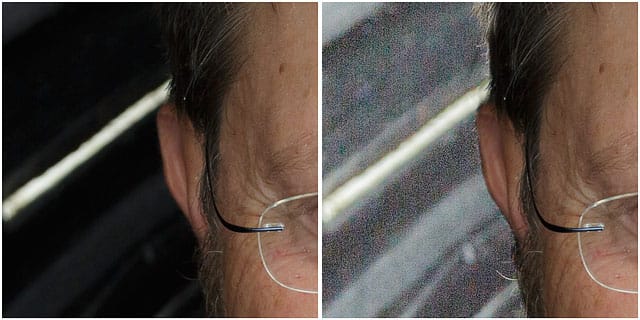
Software
I guess there’s proprietary software for image enhancement
We use Photoshop, which most people have heard of these days, and CorelPaint. We also use a programme called Deep Sky Stacker quite a lot, to align images and generate images. Registax another piece of software, is used for planetary work. Some of the images on the web, by people such as Damian Peach and others, are almost comparable to those obtained from the Hubble Telescope.
Some of the images on our website, are almost
comparable to those from the Hubble Telescope.
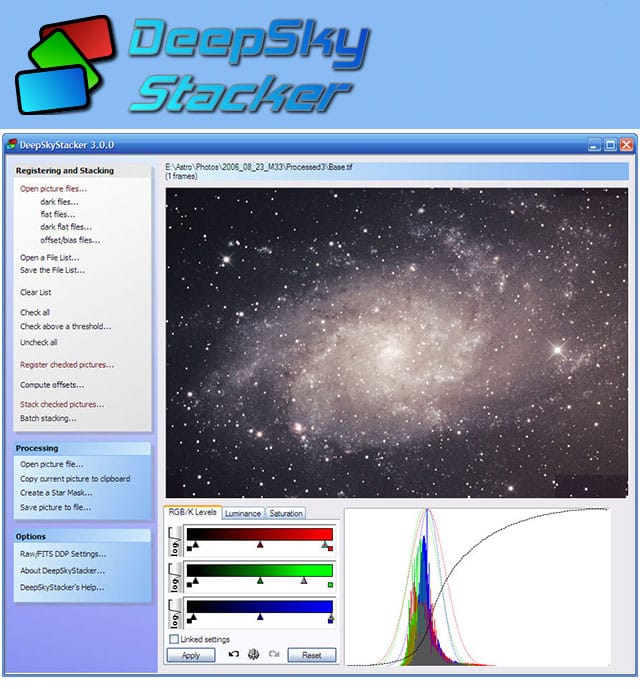

What sort of equipment is Damian using?
His telescope is actually smaller than what we use, but if you look Damian up on the Internet, you’ll see just how superb and detailed his images are.
The problem with a planetary image is, because the sky is moving all the time, you get what’s called ‘scintillation’, which is what causes the twinkling of stars in the night sky. When you’re looking at the moon, for example, it appears as though you are looking at it through water, because the air is moving. When you’re trying to capture an image, the image moves and smears, so you can never get a good sharply focused image in one shot. The way that’s overcome is by capturing multiple images, 25 or 30 frames a second, and running the images through the, Registax software. The operator selects a single sharp image from the batch, from potentially over 2,500 if you capture around one-and-a-half minutes worth, and the software will then choose any that are close to, or better than, the selected image. The software ‘stacks’ its best images, possibly two or three hundred, all together and then processes them. You end up with a single razor-sharp image, with pretty much all of the movement removed.
REF: Damian Peach
http://www.damianpeach.com/
http://www.damianpeach.com/
Meteors and personal projects
How about your own interests?
I tend to do meteor observing, because that’s what I started out on as a lad. I was quite keen to put the meteor cameras up at the site and have us become part of the UK Meteor Network. There are folks in Newbury, Farnham, Sidmouth, Cardiff and various places up north as well.
The cameras observe the sky every night, whatever the weather. We do the data reduction at HAG. That’s the removal of all the images with bats and moths [laughs] and also anything with glints of light from aircraft and bad weather nights etc. We then pass what’s left onto a central computer server. The data from around the UK is consolidated and, because we have sightings from various locations, they can be triangulated. So we’ll have point of entry, and point of burn up, giving us a 3D plot that can be projected backwards to establish a meteor’s orbit around the solar system.

REF: UK Meteor Network
(UKMON) comprises nineteen (at the time of publication) voluntary astronomical observing groups or individuals dotted around the UK. It was set up in early 2012 with the aim of it becoming the first UK-wide network using CCTV cameras to capture meteor trails across the night sky.
(UKMON) comprises nineteen (at the time of publication) voluntary astronomical observing groups or individuals dotted around the UK. It was set up in early 2012 with the aim of it becoming the first UK-wide network using CCTV cameras to capture meteor trails across the night sky.
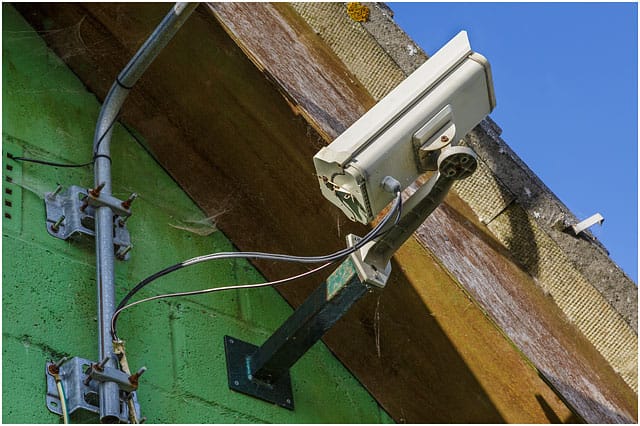
What attracted you to meteor observations in the first place?
It was cheap [laughs]. You only required a pencil and paper to get started. Obviously, it’s a bit more sophisticated since I started out.
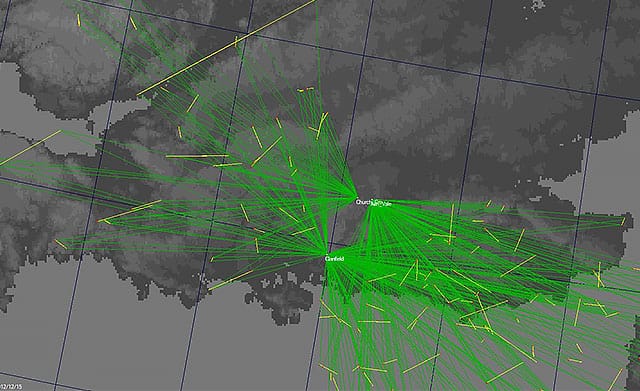
observation stations (one of which is Clanfield – HAG) [Credit UKMON]
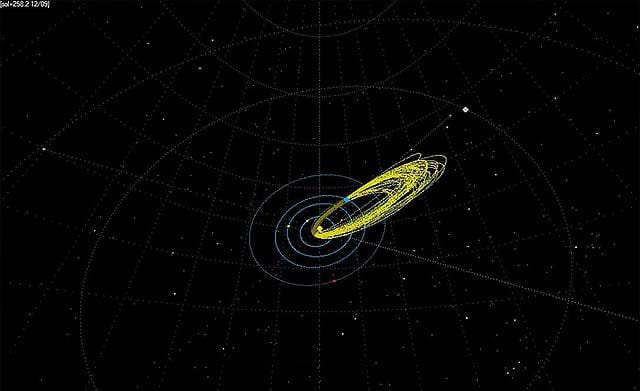
(the Geminid Meteor shower) [Credit: UKMON]
REF: UKMON Milestones
In June 2014, the UKMON team celebrated two milestones. A Total of 20,000 recorded meteors in their database and, also, 4,000 meteors recorded this year
In June 2014, the UKMON team celebrated two milestones. A Total of 20,000 recorded meteors in their database and, also, 4,000 meteors recorded this year
Weather
Did I read that you have a weather station as well?
Yes, that’s attached to the main club room. It’s useful for us for a number of reasons. Obviously, it tells us what the weather is like at the site. Some of our members have to travel a reasonable distance, so knowing if the conditions are suitable for viewing, in advance, has obvious benefits. Being aware of the temperature also means we can dress appropriately. Aside from the personal benefits, its biggest scientific bonus, at least for me, has been using the data to make allowances for the temperature fluctuations that affect the Camera imaging chip.
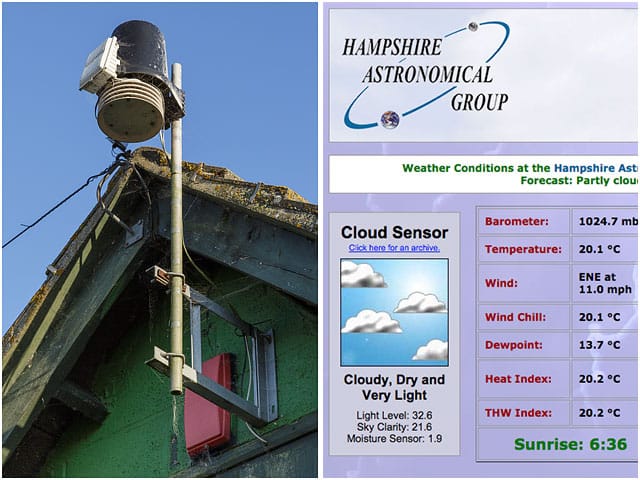
I suppose this has greater significance over longer periods of time?.
Exactly. The Epsilon Aurigae project, which ran for three years, is a perfect example of that. Epsilon Auriga is a star, which has a cloud of dust and gas orbiting it. The cloud is the equivalent distance of where Neptune and Uranus are. The cloud takes 27 years to complete its orbit around the star Epsilon Aurigae. The light dip [see earlier] has changed every 27 year cycle, during the time that it has been observed. What that means is this cloud is changing dynamically. That’s very rare for the short, in astronomical terms, time span. The last time that this occurred was in the early 1980s, when we didn’t have the camera technology that we do today.
Back then, the prevailing technology
was the Mark I Eyeball.
This time around, in August 2009, we were able to use a lot more sensitive detectors and get very, very, accurate data on what the light curve was like. Colder ambient temperatures make the camera chips more sensitive. The temperature fluctuations recorded by the weather station during that period, helped me to make allowances for that difference when submitting our findings.
The last thing is that the weather station monitors the wind speed, so we have advance warning on when its safe to open the domes. We’ve actually lost a dome in the past, due to high winds.
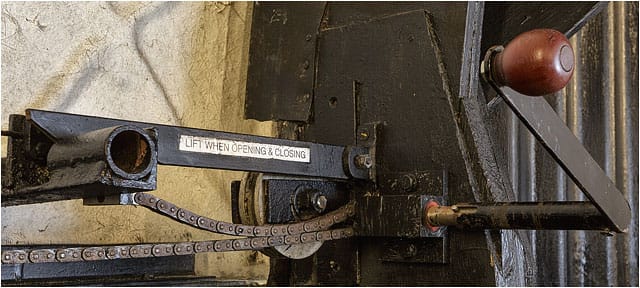
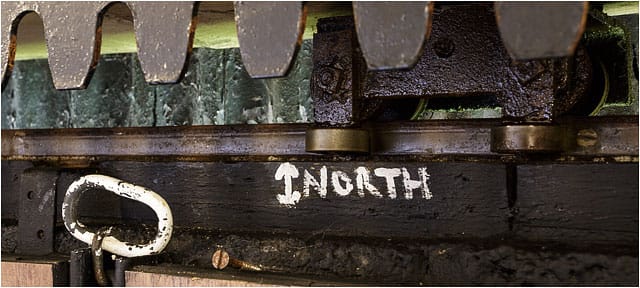
Was that during the 1987 storms?
No, for that one we had everything chained down in advance. This was before that, when one of the domes hadn’t been secured before a storm, and the wind caught the inside and lifted it like a wing. It rose straight up and, luckily for us, completely cleared the telescope before being dumped nearby. It was a complete mess, of course, but it could have been a lot worse.
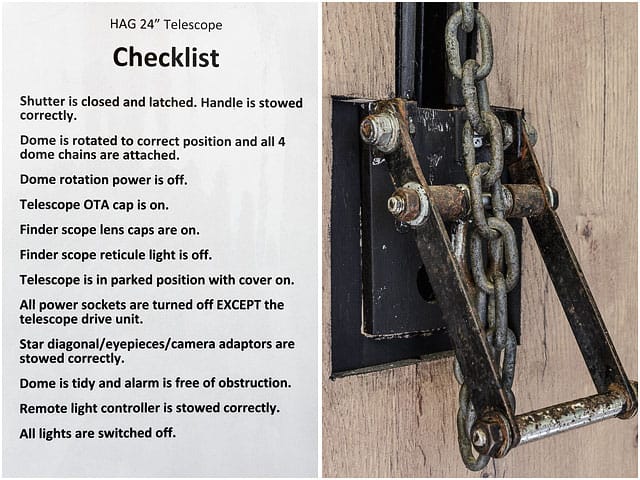
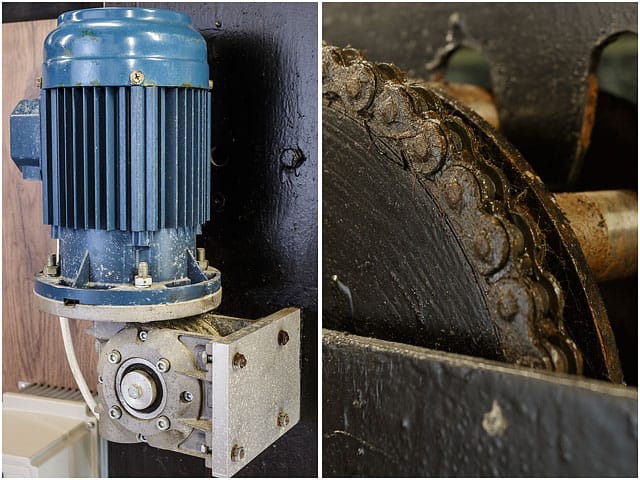
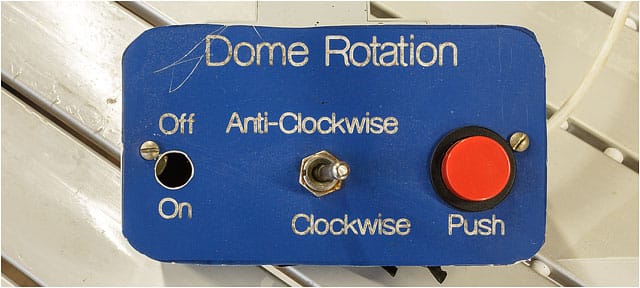
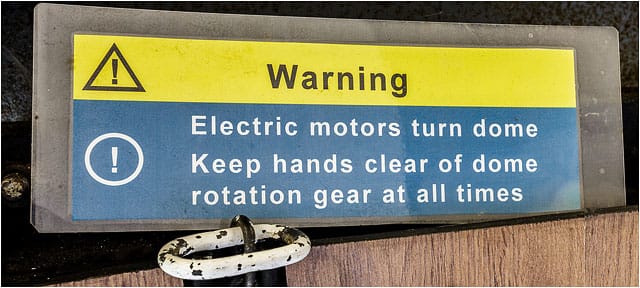
What are the best conditions for observing?
Solar observations can be carried out during the day time, of course, along with some lunar work. Generally though, it’s night time during the autumn, winter, and spring months (in the UK) because it’s darker for longer. Weather and atmospheric conditions are a big factor though.
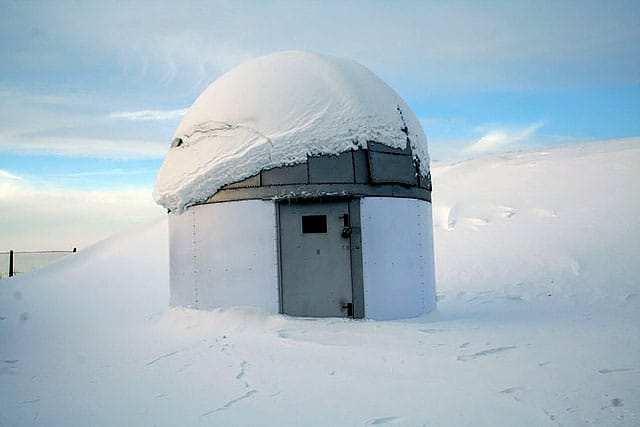
FRAS & Education
I assume that members need some education before they are allowed to use the equipment?
Yes, we’re happy to have members tag along on a Wednesday or Friday meeting, just to see what’s involved and get a feel for what they need to know, but if they want to use the telescope themselves, we take them through a training course. Along with the general ‘how to actually go about observing’ type of information, we have to cover all the safety aspects of using a telescope or moving a dome. There’s some heavy-duty equipment being moved around, so there’s a lot of opportunity to do some serious damage. By the time members have completed training on the fourth largest dome, we will have assessed them as competent to observe on their own, and they will be issued a set of keys to the site. We encourage refresher training, if you’ve not used a particular scope for a year or so, to keep up with changes in procedures or technology.
We’ve had a couple of mishaps, myself included, but, luckily, we have guys around who are engineers. They can fix most things. Within reason, of course.
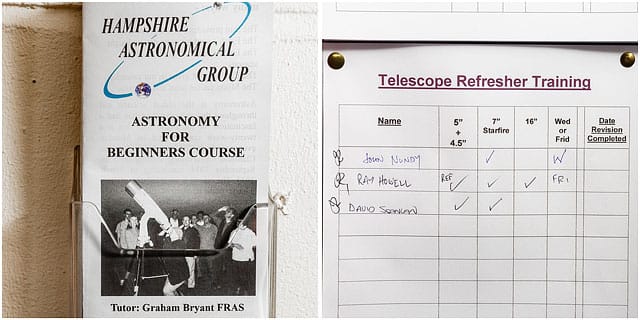
We’ve had a couple of mishaps, myself included …
When did you become a Fellow of the Royal Astronomy Society?
A couple of years ago now. The RAS has been in existence for around 200 years, and they support astronomical research and the astronomical community in the UK. It’s primarily aimed at professional astronomers, but that doesn’t meant that amateurs can’t join. I was nominated by another Fellow, because of the astronomy education that I provide. You have to be nominated, and it goes to the RAS Council where, if suitable, you are elected in, so to speak. Being a member entitles you use the letters FRAS (Fellow of the Royal Astronomical Society) after your name. We receive certain publications and the opportunity to attend annual National Astronomy Meetings. In fact, The Institute of Cosmology and Gravitation (ICG), at Portsmouth University, hosted this year’s meeting (2014) in Portsmouth’s Guildhall and University buildings.

I provide a twenty session, ‘Introduction to Astronomy’ course, one evening a week, which is open to the general public. Although it’s an introduction, it’s a significant grounding, because I tend not to be too basic. It’s quite comprehensive, covering the order of the planets through to their geology. I also give talks to other Astro’ societies and groups.
What subject matter do you cover?
When we’re approached to give talks, it tends not to be for specific topic areas of astronomy. So I have a couple of ‘wide area subject’ talks that I give. They’ll be peppered with more recent happenings, or current items of interest, to spice things up a bit. Things like the Mars Lander project in 2013 was a good one, of course. I was able to show some footage and images from that. I make great play on the role of amateurs in astronomy, because it’s one of the few areas of science that we can make a considerable contribution to the body of work that already exists. I have a talk, planned for September (2014), covering robots in the solar system.
Sightings
How do items of interest get reported?
There’s a sort of due-diligence kind of process that we follow when something is either brought to our attention or, indeed, if we, ourselves, think that we have observed something unusual. Basically, it has to be independently verified, submitted for confirmation to the UK clearing house in Basingstoke, before final approval at worldwide level in the US. After that, all manner of science and physics will be carried out on the sighting, while it’s still viewable.
Has HAG had any sightings of note?
We have one member, Ron Arbour, who specialises in Supernova discoveries; he has about thirty to his name. He has his own dedicated observatory in his back garden. He’s fully automated the process to track, image capture, download the images and process them; the whole works. So, every clear night, he sets it up all up and then goes to bed. He’ll come down some time during the night to check that everything is OK, and then reviews the results in the morning. He uses the HAG site for the first stage of reporting and confirmation.
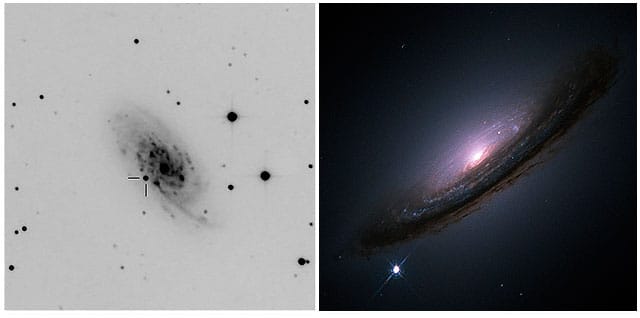
[L/H Photo credit: Ron Arbour of HAG] – [R/H Photo credit: High-Z Supernova Search Team, HST, NASA]
Outro
With no constraints such as money or time, where in the world would you like to observe from?
La Palma, Spain.
No hesitation. That’s the Holy Grail then?
It is for me. Being in Europe, it’s relatively nearby, which has its attractions. The Greenwich Observatory, which was originally in Greenwich, London, got moved out to Herstmonceux, East Sussex, after WWII, because London was getting too much light pollution and smog etc.
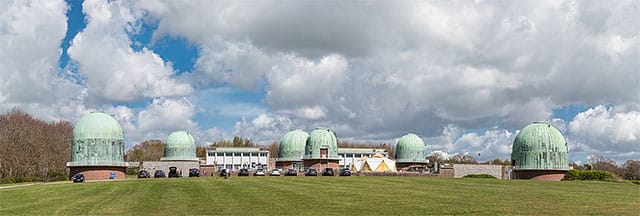
Herstmonceux: The Greenwich Royal Observatory http://www.the-observatory.org/
In fact, the HAG five inch dome came from Herstmonceux,
it was one of the first that had been built there.
Then, during the 1980s, they realised that, actually, the UK is not the best place to observe from if you have big, world class, research grade, instruments. So they looked for another place to go. They eventually decided upon the top of the Roque de los Muchachos which is the extinct volcano on the island of La Palma, Spain. The Northern European Observatory was created, which is a collaboration of a lot of European countries. If you visit now, you’d be able to see, among other things, the original Isaac Newton telescope which was previously installed at Herstmonceaux. The observatory is situated high above the clouds, way above the inversion layer.
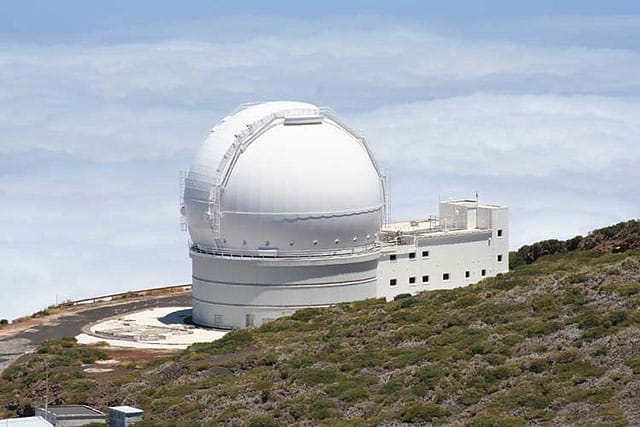
I’ve been there three times now, although you’re not allowed on the observatory site itself at night. We observe from the roadside on the edge of the volcano, and we’ve had some wonderful images. There are other locations, of course, but La Palma is the most ‘human’ friendly [laughs].
REF: Roque de los Muchachos (English: “The Rock of the Boys”) is a rocky mound at the highest point on the island of La Palma in the Canary Islands, Spain.
It’s so clear and bright, that it’s one of the few times that
you could almost read a book by the light of the Milky Way.
What’s the most common question you get from adult visitors?
They often ask if you’ve seen anything unusual, and we’re not talking about stars or planets [laughs]
If you could have a star named after you, what would you call it?
I wouldn’t have a star named after me, it’s actually a practice frowned upon by true astronomers and official astronomical organisations. Maybe an asteroid. If you discover an asteroid, and it’s confirmed, the International Astronomical Union will offer you the opportunity to give it an officially recognised name. What name would I choose? Probably Terri Jean, after my wife.
Winding up, is there anyone, or anything extra that you’d like to have mentioned?
The biggest shout-out should go to Patrick Moore; he’s pretty much the patron saint of UK astronomers. Not only for the work that he did, but also for his encouragement and enthusiasm in getting others, like myself, as a small boy, interested in the science.
Also Peter Seidenstucker, who is a friend of mine that I’ve known since I was twelve. When I came to Portsmouth as an eleven year old, after my father died, and he probably doesn’t know it, Pete, in a sense, fulfilled the father figure role in my life. He was twenty, I think, at the time, and we’re still good friends now. He took me under his wing, and we used to do a lot meteor observing on a Saturday night, with girlfriends. If it was cloudy and we couldn’t observe, well I’ll leave you to join the dots [laughs]. We’ve been lifelong friends, really, and I owe a lot to him in that respect. Thanks Peter.
Web Links and References of interest
HAG: Hampshire Astronomical Group
Web: http://www.hantsastro.org.uk/
Contact details: http://www.hantsastro.org.uk/contact/index.php
HAG Science Projects
http://www.hantsastro.org.uk/projects/index.php
http://www.hantsastro.org.uk/projects/epsilonaurigae/index.php
http://www.hantsastro.org.uk/projects/exoplanets/index.php
RAS: Royal Astronomical Society
http://www.ras.org.uk/
UK Meteor Observation Network
UKMON: http://ukmeteornetwork.co.uk/
National astronomy meetings
http://www.nam2014.org/
Night Sky and Astro Photography Tutorials
https://www.lightstalking.com/night-sky-photography/
Software:
http://www.astronomie.be/registax/index.html
http://deepskystacker.free.fr/english/index.html

